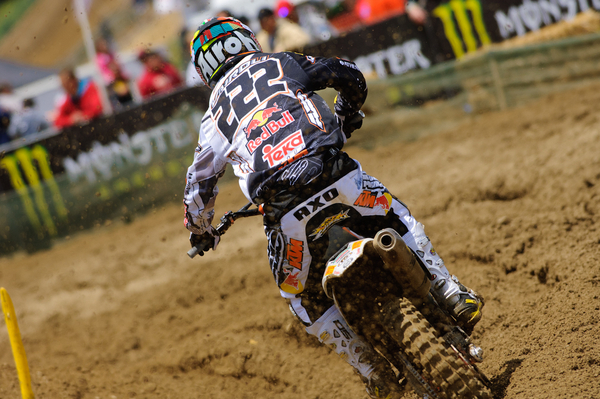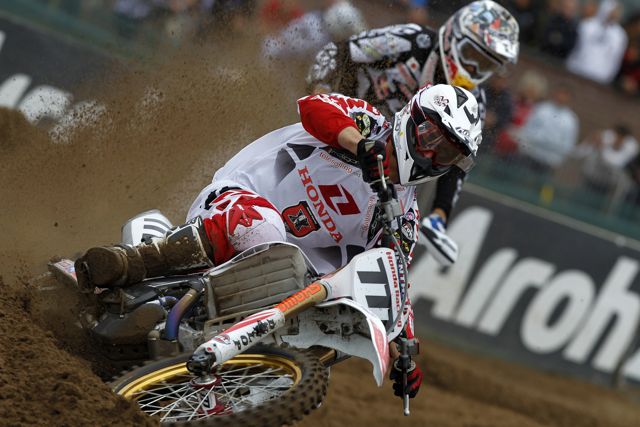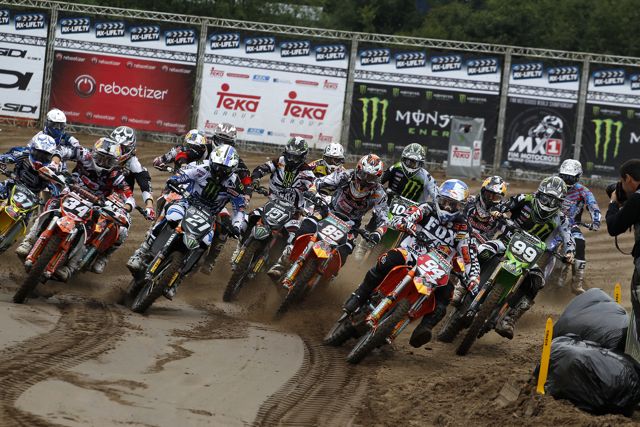The Lost GP:
5 Reasons To Like The World Championship
By Paul Quesnel
Photos by THE James Lissimore & Ray Archer
The year was 2010 and it had been little over a decade since the competitors of the FIM world motocross championship had battled it out on American soil. Furthermore, it had been a whole 18 years since a United States Grand Prix was held in southern California, the powder keg of American Motocross. After a whirlwind of rumors and speculation early in the year, it was finally announced that the Glen Helen AMA national was to be discontinued and replaced with an FIM sanctioned USGP. For many fans of American racing, this was devastating news on the grounds that Glen Helen has often been regarded as a jewel in the AMA circuit with its spectacular hills and brutal terrain. For Youthstream (promoter of the GP’s), it was a chance for the ever growing organization to gain a much needed foothold in the United States. The event which would later be coined as, “the race of the century”, by Youthstream and Bud Feldkamp (President of Glen Helen), turned out to be an amazing race with scarce fans there to witness it. The dismal turnout was attributed to holding a European event on an American Holiday (Memorial Day) and the race was given another chance and put back on the schedule for the 2011 season. With more time to prepare and now on a date that didn’t coincide with a U.S. day of remembrance, the event again struggled to gain any interest from the American motocross industry, not to mention the fans. Just months later, the 2012 world motocross championship calendar was released and absent was the legendary motocross facility of Glen Helen. When questioned, both Youthstream and Feldkamp expressed that their relationship was still extremely good and that their willingness to work with one another remained strong. The reason the USGP was taken off the schedule was due to the lack of support and enthusiasm from the fans, the US riders, and the whole industry. Plain and simple, it just didn’t seem like anyone cared. So why does America hate the GP’s so much? Why have they gained our interest in the past but fail to do so now? Would a USGP held on the east coast gain more interest from the fans?
First of all, Americans don’t hate the world motocross championship. At least not all of us. There is a small majority of hardcore fans here that were extremely excited to see the return of the USGP and were equally disappointed to see it go away so soon. To several of us, the GP tour is just another awesome series we get to admire and it was a real shame to see that some enthusiasts really didn’t care for it at all. As for those particular people, all they really care about are the top riders and perfectly prepped tracks of the AMA. In their head they think, why get out of our little comfort zone to go and support a foreign event? Why go watch a GP when we have more than five pro AMA races in California every year? Why travel to a professional motocross race that doesn’t include Chad Reed or Ryan Villopoto? Well if you are one of the people asking these questions, here are some reasons why you should attend the USGP, if it ever returns.
 |
|
Tony Cairoli- 5-time World Champion and one of the best riders in the world. (Lissimore) |
Speed
Who is faster, the aggressive young riders of the American motocross series or the super-smooth technicians of the world championship? It is a question that has been thrown back and forth across the pond ever since the U.S. won their first MXDN in ’81 and showed that they had the speed to run with the best Europe has to offer. It has divided fans all around the world as well as created the motocross version of World War III on many of message boards. The big problem with the question is that no one is ever going to be able to conceive a definitive answer. Different bikes, different tracks and different rules. You can’t compare the two series mono y mono because for as similar as they are, they are also very different. It’d be like trying to compare NASCAR with Formula 1, it just doesn’t work. Saying that, most people would have a good argument when saying the U.S. has the upper hand in the category of flat out speed due to their numerous MXDN wins but, on the other hand, the MXDN is a team race and an event where you might not necessarily see the individual’s full talent. If you were on the European side of the debate, you would also have some valid points due to the fact that the GP’s have created numerous American champions past and present. The point trying to be made here is that if you think you are going to a GP to see a bunch of slow riders that aren’t on the same level as the guys here in the U.S. then you are strongly mistaken. Their top riders have beaten our top riders numerous times and vice versa. The speed of the best guys in each series is close enough now that no one should be able to use this topic as an excuse as to why they won’t attend a Grand Prix. Period.
Bikes
Grand Prix racing is the only series around where the best riders in the world get to race prototypes of future production bikes. Unlike American racing where bikes have to adhere to strict production rules, the world championship allows their race machines to be pure factory one-offs. Free from the restraints that plague the U.S. factory squads, teams overseas are allowed to customize frames, engine cases, transmissions, subframes, swingarms and etc. Going to a GP is like going to Disney world if you’re an extreme bike enthusiast. They are allowed to do some really cool things with the machines and unlike the AMA, they will actually tell you about all the trick stuff because they are not breaking any rules. Although their bikes might resemble everything coming out of the U.S., they are able to completely tailor every aspect of the machine to fit the rider’s needs. For example, most frames and swingarms overseas will look exactly like the stock production units but are actually custom built and use different wall thickness’ in key areas in order to tune in the right amount of flex for the rider. Last year, the Martin Honda team used GET date recorders (the same thing James Stewart had in Phoenix when accused of using traction control) as a GPS satellite receiver that could accurately map the track and helped to pinpoint precisely where the bike was when a reading of fuel or ignition was taken. The reason this is so cool is because they would use all those complicated devises to clock section times on the racetrack and via lights mounted in the barpad, the rider could tell if he just completed the section faster or slower than his previous lap. Although all that fancy technology might not make the bike or the riders any quicker, it’s awesome knowing that when you go to a GP you will be looking at some of the most exotic dirt bikes on the planet.
 |
|
Up and coming Russian rider Evgeny Bobryshev on the Martin Honda team. (Archer) |
Competition
Most fans of the AMA series don’t realize how lucky they are to live in an era where they don’t know who’s going to win the race before it even starts. With the likes of Villopoto, Stewart, Reed, Dungey and Canard, we are all spoiled with exciting races and multiple winners. Gone are the days when there were only two men on the starting gate every weekend that had a shot at victory and for that, we should all be thankful. But what most people don’t realize is that these days, the races across the pond are just as competitive, if not more. Just as we have five major title contenders here in the U.S., the Grand Prix’s have Cairoli, Desalle, Frossard, Bobryshev, and Pourcel. Any one of those riders can win at any given time and by no means does Cairoli (5-time world champion) have a lock on the series as one might think. Insanely enough, Nagl, Philipaerts, Leok, Paulin and De Dycker also have a good shot at winning motos if not overalls. In the 250 class, it’s shaping up to be a great battle between Herlings, Osborne, and Searle for the championship and not one of them really has a huge advantage over the others. Other than that, KTM’s Jeremy Van Horebeek and Jordi Tixier will surely be fast as well as Tonus, Anstie and Nicholls. As it stands right now, all the top riders are on a level peg in both classes. Not one of them came out and absolutely took control of the series last year (excluding Roczen) and its going to be really exciting to see who’s coming into 2012 ready to win.
Tracks
Excluding Southwick, every track on the AMA national circuit is the same. Bring in dirt, till dirt, add sawdust, water to perfection, repeat. That is the formula they use for every track to achieve optimal conditions for the riders, fans and TV. While that is all well and good, it’s not necessarily moto down to the core. That is why it’s good to see that the tracks of GP circuit include a wide variety of terrains that truly test man and machine. From the legendary sand tracks of Valkensward and Lommel to the hard pack surfaces of Fermo and St Jean D’Angely, the tough Grand Prix course’s really reiterate that in order to win the championship, you really do have to be the best in the world. Newly added to the schedule for 2012 is the GP of Russia as well as the GP of Mexico. Both will surely serve up some challenges with their unknown terrain and that is one of the great things about Grand Prix racing. Every weekend has new challenges for the riders and no two tracks are alike. The promoters don’t bring in dirt from somewhere else to perfectly prep the track and they make you ride the earth that is native to the area you are in, even if it’s not that great. But that’s what motocross is all about and that that’s the way it should be. Half the fun of watching the races is seeing how the riders deal with the elements. When you take part of that equation out by making every track exactly the same you are really just making it less interesting for everyone else and you are taking away from the character of the track. When Unadilla looks exactly like Redbud, you know you’re going too far.
 |
|
The MX2 class roars into the first turn. (Archer) |
National Pride
Imagine if the USGP was the only big motocross race in the states every year and there was only one American in each class, because that is what it’s like for most other countries around the world. When the Grand Prix’s go to places like Belgium, Germany, and Italy, there is such an incredible sense a national pride and it’s just something we don’t have here in the states. For us, it’d be like rooting for our local pro rider racing in our area national. That sense of satisfaction you getwhen a member of your community succeeds has an awesome way of bringing people together and if you don’t believe it just look at the second to last round in Germany last year. Fans were going absolutely crazy for Ken Roczen and you have to think that between him and Max Nagl, they probably sold more bikes throughout Germany in 2011 by just being themselves than any other kind of marketing scheme you can think of. The same goes for Jeffrey Herlings in Holland as well as Bobryshev in Russia. It’s insane how just one person can completely resurrect the sport of motocross like Bobryshev has done for Russia recently and now the GP’s are returning there for the first time in ten years. Saying all that, it makes it even more disappointing when you think about how barely any fans showed up at the USGP the last two years to support the likes of Zach Osborne, one of the only Americans competing. In our series we just don’t have that same type of affection towards our countrymen and although it’s really not our fault seeing that all we do is compete against each other, it’s just another thing that makes the Grand Prix’s worth paying attention to.
 |
|
Steven Frossard blows up a Lommel berm (Archer) |





